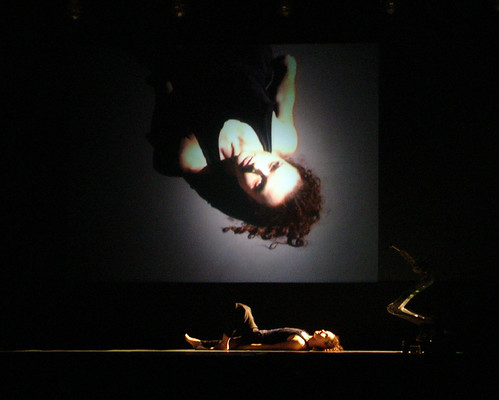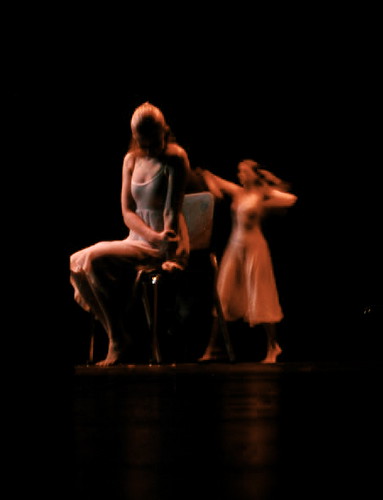Last weekend I had the pleasure of attending two contemporary dance performances here in Houston. Coincidentally, in both works the choreographers mined their own backgrounds and experiences to generate material.
In House of Mind, Seattle choreographer Pat Graney, focuses on the concept of memory. Her work went beyond the typical theatrical presentation on a proscenium stage. In fact she and her team constructed an entire art installation based on her childhood memories which the audience could tour before taking in the performance. The dancing was abstract (and not terribly “dance-y”) but made interesting use of the space (much like site-specific work except she had created the site as well as the work) and props (specifically some wooden chairs and large kitchen drawers).
You can read more about the performance in the review I posted on my personal site.
Tetris, by dancer/artist Toni Leago Valle, was much more theatrical than Graney’s work. Valle used popular music from her past, included soundbites and video clips from recent historical events (focusing on the 1980’s and early 90s), and added humor and drama to the dancing in order to tell what was essentially her own coming of age story. Valle’s work also displayed creative use of movable set pieces that were shaped like the blocks in the Nintendo game Tetris. The piece was also inspired by an investigation into a psychological concept/technique called Voice Dialogue which theorizes that individuals have many “selves” which make up their personality. You can read more about that aspect of the dance in my review.
Applications
I share these two examples with you because, even if you are not creating artistic concert dance works, there are lessons and applications that you can take away from these for use in your own choreography – even recital dances!
In both examples, audiences really connected with the work being performed. Why?
- Because viewers were able to find/recognize themselves in the memories or stories of the past being presented. Audience members’ own memories and experiences surfaced as the choreographers explored their personal histories.
- The choreographers’ strong connection to the material translated to the audience, giving the dances a very sincere yet unforced quality – audiences like that.
- Both pieces were nostalgic without being overly sentimental. Sentimental will grab some folks but, tug too hard at those heart strings and you’ll leave the audience feeling as though they’re being manipulated like a marionette. Showing restraint in this area will be more likely to melt even the hardest hearts.

Autobiographical dance doesn’t necessarily have to be literal or chronological.
Sometimes a story laid out in chronological order is not all that interesting. Consider this: Your friend traveled to Paris and recorded everything she did and everywhere she went on video. She has placed it all on a DVD, unedited. Another friend that went on the same trip took some photographs that highlighted her journey. Her photos are all out of order and she rarely captioned them but she’s put the images together in a slide show. Which would you rather sit through? I think most people would rather see the slide show which, even without the details, gives an idea about what kind of trip it was and allows them to interact or form questions as they watch. It would be okay to mix the slides and video too but, the point is, be wary of boring the audience with too much detail, leaving no room for interpretation or imagination.
Use sound, music, and even video projection in creative and unexpected ways.
- Both of the works above used clips of people speaking in addition to musical selections. Sources for these soundbites included pieces of an interview, clips from movies and news broadcasts, and someone reading something or describing something. Both, at one point, also utilized a dancer singing a song portion on stage.
- Musical selections included songs directly from or that evoked a period in history. Sometimes there was a juxtapositioning of moods or styles, for instance an upbeat or uplifting selection that accompanied movement with dark or gloomy themes, or a slow adagio during a song to which one would normally Jitterbug.
-

Photo by Clav Each of the above performances incorporated video projection as well. Tetris used actual clips of news footage and movies from the time period that often accompanied the dancing. The dancers sometimes ignored the clip but usually interacted with or acknowledged these almost as they would another dancer/character in the piece. In House of Mind the projections sometimes appeared in unique places such as the back of a chair, and in various locations throughout the space. This of course takes proper equipment to accomplish but consider other ways to incorporate images (moving or not) in your dance in unexpected ways. Pieces of a set come together to form an image, dancers recreate the characters in a painting or the action in a famous movie clip, pictures are revealed when a particular prop is flipped over… use your imagination!
Props and sets don’t always need to be used for their intended purposes.
- In House of Mind the dancers used chairs in completely unique ways – not just for sitting. Chairs are used a lot as props in dance but, as many chair dances as I’ve seen, I never felt like the material was tired or familiar. The kitchen drawers had many, many uses throughout but the only thing they ever “contained” were the dancers! The dancers even executed unique methods of ascending or descending an ordinary staircase.
- In Tetris the set pieces were differently shaped blocks. They were most often in pieces but fit together to form a hollow cube which at one point caged (or perhaps protected) the main character. They were also hidden behind, stacked, danced upon, dangled from, sat upon, and moved about to be utilized in the background and as a featured prop of sorts.
- At least one, but possibly both choreographers, relied on their dancers in the creation of movement. Therefore in the use of props in particular (but certainly in other movement), the dances benefited from tapping into the creativity of more than one mind. Allowing dancers to explore and experiment with props or set pieces is a great way to find unique and original uses for them.
Translation

It is easy to get stuck in a rut with choreography, particularly if you create multiple dances year after year for students. Seeing the work of others can really encourage a flow of ideas. In this particular case, although there were certainly lots of ideas to be gleaned from the concerts I saw this weekend, the one that stands out is just how much raw material there is in your very own personal history.
There is no dance style, age group, or setting for which this idea could not be repurposed. Think back to your experiences growing up. What did it feel like to when you got that first pair of tap shoes and practiced in the kitchen? Can you capture that feeling in movement? Could oversized props add to the dance? What was your first day of high school like? Can you choreograph a ballet dance that conjures the feelings and/or includes the characters, cliques, or experiences of that day? What were the songs of your parent’s generation? Can you construct a jazz dance to one or more of these songs but fuse it with important events/themes of your own generation?
These are just a few examples. Do you have examples of your own that you’ve used in choreography? Or, that you’ve just thought up? Also, let me know if this article has inspired you. I’d love to hear about the result!
Nichelle Suzanne is a writer specializing in dance and online content. She is also a dance instructor with over 20 years experience teaching in dance studios, community programs, and colleges. She began Dance Advantage in 2008, equipped with a passion for movement education and an intuitive sense that a blog could bring dancers together. As a Houston-based dance writer, Nichelle covers dance performance for Dance Source Houston, Arts+Culture Texas, and other publications. She is a leader in social media within the dance community and has presented on blogging for dance organizations, including Dance/USA. Nichelle provides web consulting and writing services for dancers, dance schools and studios, and those beyond the dance world. Read Nichelle’s posts.

